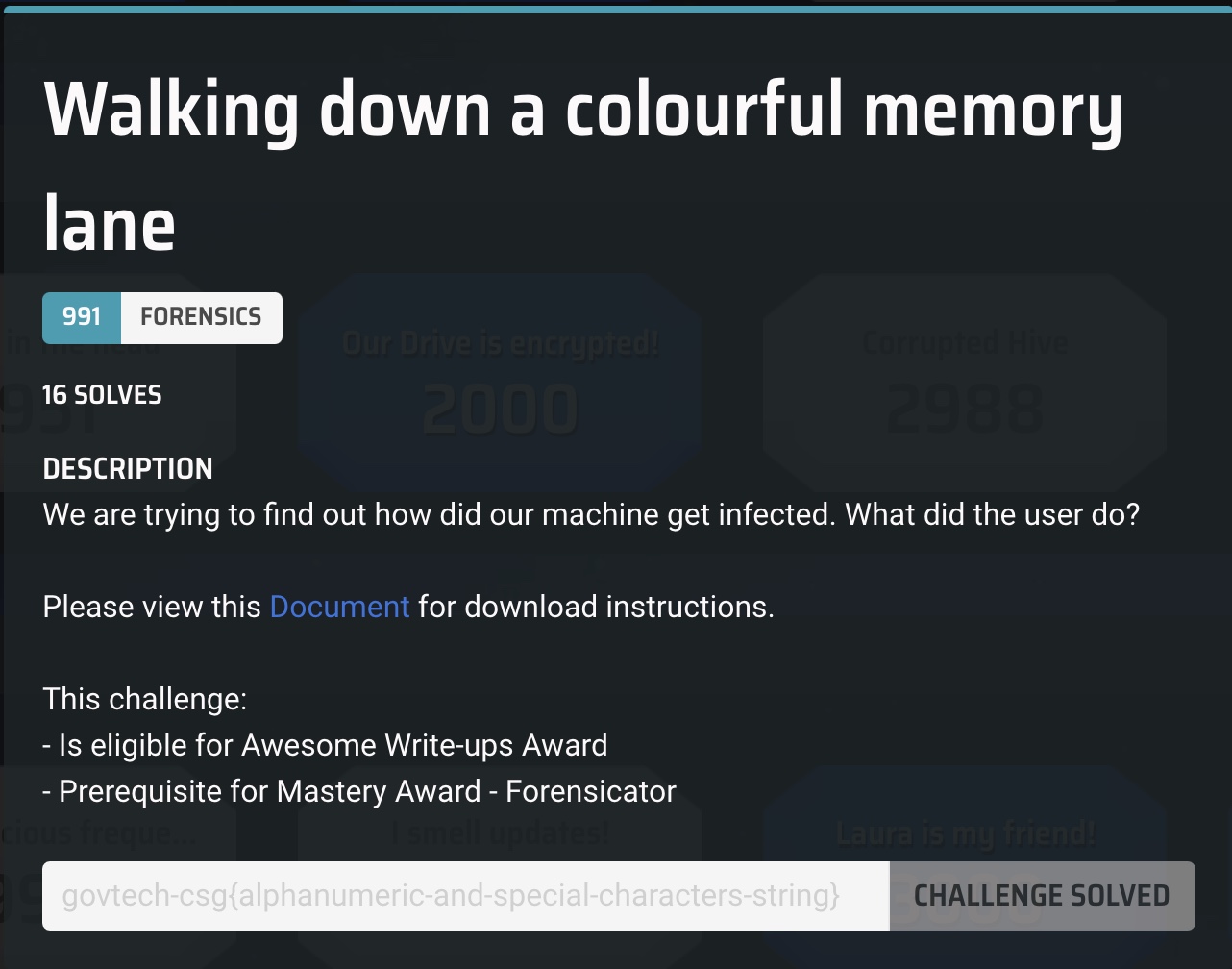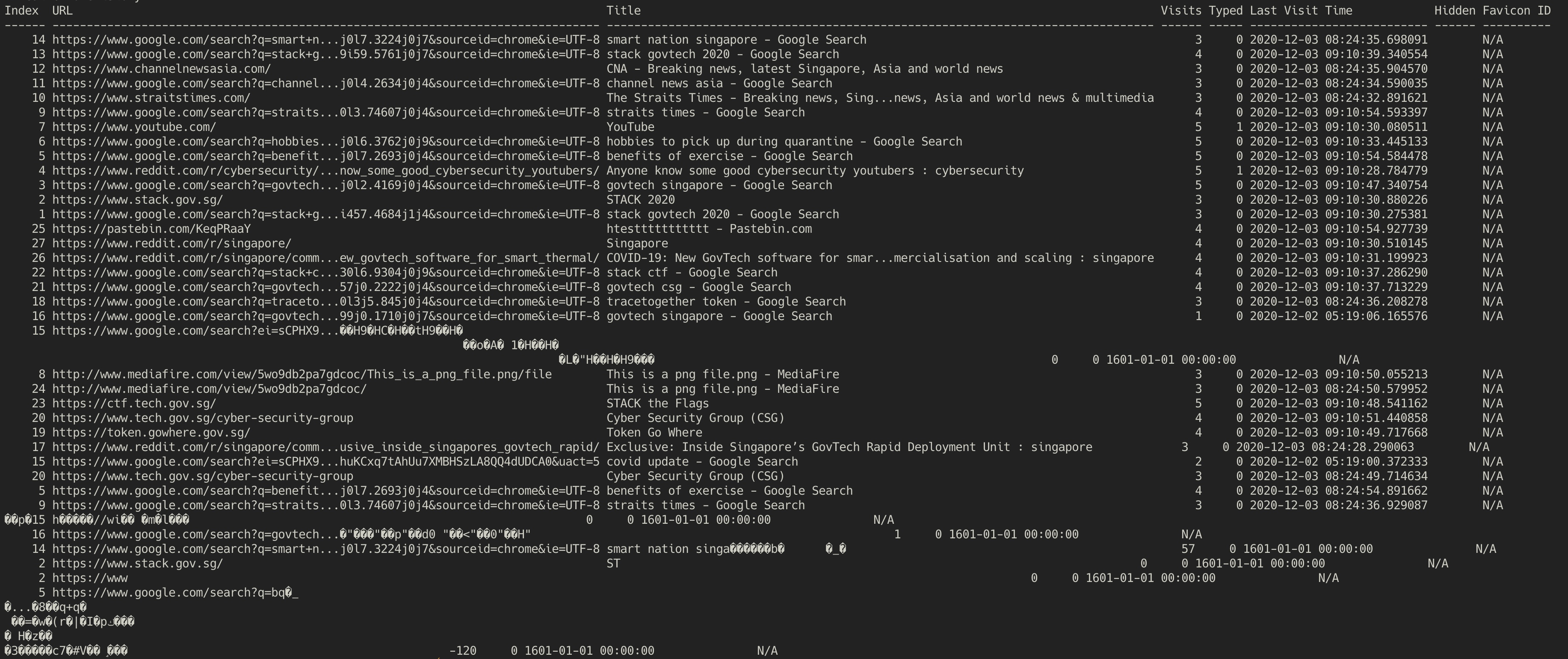Summary: Analysing the provided memory dump yields a hosted PNG file containing a steganographic message.

Walking down a colourful memory lane
991 FORENSICS
16 SOLVES
DESCRIPTION
We are trying to find out how did our machine get infected. What did the user do?
This challenge:
- Is eligible for Awesome Write-ups Award
- Prerequisite for Mastery Award - Forensicator
For this challenge, we are given a memory dump file.
$ ls -la
-rwxrwxrwx 1 amon staff 2147483648 Dec 3 19:33 forensics-challenge-1.mem
To analyse this, we can use a dockerised version of Volatility.
$ docker pull blacktop/volatility
To start, we need to identify the operating system profile of the image. This can be done with the imageinfo plugin.
$ docker run --rm -v `pwd`:/data:ro blacktop/volatility -f forensics-challenge-1.mem imageinfo
Volatility Foundation Volatility Framework 2.6.1
INFO : volatility.debug : Determining profile based on KDBG search...
Suggested Profile(s) : Win7SP1x64, Win7SP0x64, Win2008R2SP0x64, Win2008R2SP1x64_24000, Win2008R2SP1x64_23418, Win2008R2SP1x64, Win7SP1x64_24000, Win7SP1x64_23418
AS Layer1 : WindowsAMD64PagedMemory (Kernel AS)
AS Layer2 : FileAddressSpace (/data/forensics-challenge-1.mem)
PAE type : No PAE
DTB : 0x187000L
KDBG : 0xf800029fb0a0L
Number of Processors : 1
Image Type (Service Pack) : 1
KPCR for CPU 0 : 0xfffff800029fcd00L
KUSER_SHARED_DATA : 0xfffff78000000000L
Image date and time : 2020-12-03 09:12:22 UTC+0000
Image local date and time : 2020-12-03 17:12:22 +0800
Now, we can use the Win7SP1x64 profile to perform further analysis. Next, dumping the process tree with pstree tells us that two interesting processes were running: chrome.exe and notepad.exe.
console
$ docker run --rm -v `pwd`:/data:ro blacktop/volatility -f forensics-challenge-1.mem --profile Win7SP1x64 pstree
Volatility Foundation Volatility Framework 2.6.1
Name Pid PPid Thds Hnds Time
-------------------------------------------------- ------ ------ ------ ------ ----
0xfffffa801a3dd7f0:explorer.exe 2460 2432 32 905 2020-12-03 08:51:58 UTC+0000
. 0xfffffa801aed8060:notepad.exe 3896 2460 5 286 2020-12-03 09:10:52 UTC+0000
. 0xfffffa801ac4d060:RamCapture64.e 4832 2460 6 70 2020-12-03 09:11:24 UTC+0000
. 0xfffffa80199e6a70:chrome.exe 2904 2460 33 1694 2020-12-03 09:10:20 UTC+0000
.. 0xfffffa801ad9eb30:chrome.exe 3328 2904 13 231 2020-12-03 09:10:33 UTC+0000
.. 0xfffffa801ae2e7d0:chrome.exe 3456 2904 12 196 2020-12-03 09:10:42 UTC+0000
.. 0xfffffa801addfb30:chrome.exe 3380 2904 13 304 2020-12-03 09:10:34 UTC+0000
.. 0xfffffa801ae269e0:chrome.exe 3444 2904 13 231 2020-12-03 09:10:38 UTC+0000
...
. 0xfffffa801a17db30:lsm.exe 504 376 10 146 2020-12-03 08:51:25 UTC+0000
0xfffffa8018dac040:System 4 0 86 572 2020-12-03 08:51:24 UTC+0000
. 0xfffffa8019355b30:smss.exe 240 4 2 29 2020-12-03 08:51:24 UTC+0000
Since Chrome is involved, we can use the Chrome History volatility plugin written by Dave Lassalle.
Running the plugin gives us a list of URLs visited by the user.
$ docker run --rm -v `pwd`:/data blacktop/volatility --plugins=volatility-plugins/ -f forensics-challenge-1.mem --profile Win7SP1x64 chromehistory
...

The URL [http://www.mediafire.com/view/5wo9db2pa7gdcoc/] looked extremely suspicious. Downloading the file hosted at the link gives us an extremely tiny PNG:

Examining the file shows that it is a valid PNG but contains very little data:
$ file This\ is\ a\ png\ file.png
This is a png file.png: PNG image data, 64 x 1, 8-bit/color RGB, non-interlaced
$ xxd This\ is\ a\ png\ file.png
00000000: 8950 4e47 0d0a 1a0a 0000 000d 4948 4452 .PNG........IHDR
00000010: 0000 0040 0000 0001 0802 0000 00e1 0f3f ...@...........?
00000020: 4000 0000 3249 4441 5478 9c63 4ccf 2fe3 @...2IDATx.cL./.
00000030: fdf6 f6cb 0906 6e2b 895f 673e 1db6 e7d1 ......n+._g>....
00000040: 7fb0 8bf5 abfd f937 7ff8 2dd9 3ff2 719c .......7..-.?.q.
00000050: 6d6b 6618 c400 004e 9312 0298 1553 a700 mkf....N.....S..
00000060: 0000 0049 454e 44ae 4260 82 ...IEND.B`.
Suspecting that the file hides some data through steganography techniques, we can use zsteg to automatically attempt extracting data through a variety of schemes and reveal a possible flag.
$ zsteg -a This\ is\ a\ png\ file.png
b8,r,lsb,xy .. text: "gthsm0_d3B3"
b8,g,lsb,xy .. text: "oe-g3rRG3lz"
b8,b,lsb,xy .. text: "vcc{my3rnu}"
b8,rgb,lsb,xy .. text: "govtech-csg{m3m0ry_R3dGr33nBlu3z}"
b8,bgr,lsb,xy .. text: "vogcetc-h{gsm3myr03R_rGdn33ulB}z3"
b8,rgb,lsb,xy,prime .. text: "h-csg{0rydGr"
b8,bgr,lsb,xy,prime .. text: "c-h{gsyr0rGd"
b8,r,lsb,XY .. text: "3B3d_0mshtg"
b8,g,lsb,XY .. text: "zl3GRr3g-eo"
b8,b,lsb,XY .. text: "}unr3ym{ccv"
b8,rgb,lsb,XY .. text: "3z}Blu33ndGr_R30rym3msg{h-ctecgov"
b8,bgr,lsb,XY .. text: "}z3ulBn33rGd3R_yr0m3m{gsc-hcetvog"
b8,rgb,lsb,XY,prime .. text: "3z}m3mh-c"
b8,bgr,lsb,XY,prime .. text: "}z3m3mc-h"
Flag: govtech-csg{m3m0ry_R3dGr33nBlu3z}

Leave a Comment